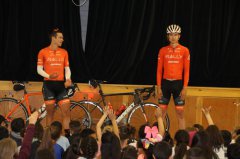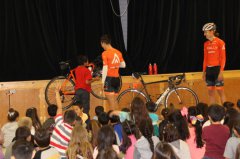Article and photos by Mary Alice Murphy
Tour of Gila cyclists speak to Bayard Elementary students 041118
Tour of Gila cyclists speak to Bayard Elementary students 041118
The entire Bayard Elementary School student body showed up to hear from Pro cyclists
Tour of Gila cyclists speak to Bayard Elementary students 041118
Last year's Tour of Gila overall winner Evan Huffman, left, and his Rally Cycling team member, Kyle Murphy, talk about professional cycling.
Tour of Gila cyclists speak to Bayard Elementary students 041118
Jared Morales, Bayard Elementary second grader, asked how heavy the bicycle was and got to lift it himself.
Tour of Gila cyclists speak to Bayard Elementary students 041118
Huffman makes a tour around the gym for the students.
On Wednesday morning, April 11, 2018, students at Bayard Elementary got to meet two professional cyclists from Rally Cycling. Evan Huffman, last year's Tour of the Gila overall winner in the General Classification for men, and his team member Kyle Murphy talked to the students and answered some of their questions.
Murphy said: "Why do we do it? We love riding bikes." He also gave the students some safety tips and tricks:
1) Always wear your helmets
2) Have reflectors and lights on your bikes, especially, if you ride at night.
3) Always ride on the right side of the road.
He reminded the students that if they want to be professional cyclists, they must eat healthy, get lots of sleep and drink lots of water. "Stick with the whole foods, not junk food. It's important for us to stay in shape for riding competitively."
Huffman said: "We're excited for the race next week. The Tour of the Gila is a five-day, five-stage race. We have to eat well and sleep well to recover for the next day. The last day is almost 100 miles with big hills. The first day is 90 miles; the second day 78 miles; the third day is about 15 miles of time trials; and the fourth day on Saturday, is the Downtown Criterium, which takes an hour to an hour-and-a-half in a circle on the streets of Silver City. Our team won last year and we're excited to be back."
Murphy cautioned the students to "always know what you're capable of. Don't do dangerous things. You'll improve with practice. Get your parents to take you to dirt roads, where you are safest, with fewer vehicles, and you can go faster."
Huffman said when riding on a street, students and all cyclists should stay to the right of the solid white stripe or in a bike lane. Sometimes, smaller kids can ride on a sidewalk, but it's not the safest. It's safer to have separation from cars in a bike lane.
To a question about how many riders, Huffman said about 400 professional and amateur cyclists will be competing. "We have about 120 in the professional category. Seventeen teams, with seven people per team have registered."
When a student asked what happens if a bicycle breaks, Huffman said: "Sometimes our bikes break, and we have to fix them. It can be frustrating."
Another student asked how long he had been a professional. "I have been a pro since 2013. It takes a lot of hard work." Murphy said he had been a pro for four years.
A student asked why they wore tight clothes. Murphy said: "We wear tight clothes, which help us go faster. They are made of a fabric that wicks away moisture, so we don't get all sweaty."
When a student asked how much they made, they kind of chuckled. "We are paid enough to stay healthy, and come here and race," Huffman said. "We are not paid like the NFL or NBA."
Murphy asked how many students rode their bikes to school. A few raised their hands. "When I was going to school," he said, "I rode my bike because it was faster than riding the school bus. I could sleep later."
A student asked how heavy the bicycles were and Huffman said their racing bikes weight about 15-16 pounds. He invited the student, Jared Morales, to pick up the bicycle, which he did and held it up with one hand.
To a question about how they kept their feet on the pedals, Murphy showed them the clips on the shoes that connect to the pedal. "It's easy to pop your foot out. But not when you start out. You have to learn how."
He also answered the question about whether the bicycles were made of aluminum.
"No, these bicycles have carbon fiber frames. They are really lightweight and durable."
Each cyclist hopped on his bicycle and took one turn around the gym. Afterward, students gathered around them to learn more before heading back to class.



